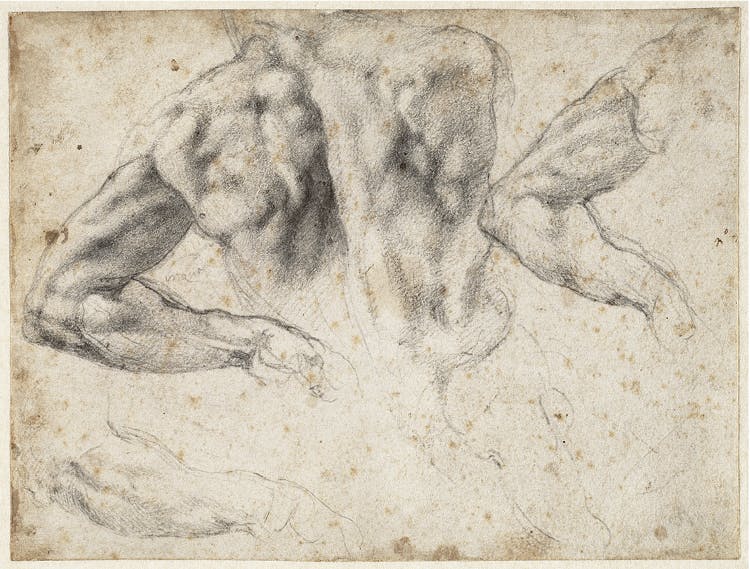
- Magazine Article
- Exhibitions
Mind of the Master
Michelangelo's preparatory drawings provide a glimpse into his genius

Study of the back and left arm of a male nude, for the tomb of Giuliano de’ Medici, 1523–24. Michelangelo Buonarroti (Italian, 1475–1564). Black chalk; 19.2 x 25.7 cm. Teylers Museum, purchased in 1790. © Teylers Museum, Haarlem
“The world has many kings, but only one Michelangelo,” wrote poet Pietro Aretino in a letter to the artist in 1537. No stranger to praise, the sculptor, painter, and architect Michelangelo Buonarroti gained widespread fame over the course of his 88 years, a lifespan that encompassed the height of the Italian Renaissance—a moment ripe for such a talented individual to flourish. Championed by patrons including the Medici banking family in Florence and a succession of popes in Rome, Michelangelo created works that still astound us today, from the Sistine Chapel ceiling frescoes and the marble sculpture of David to the design for the dome of Saint Peter’s Basilica.
Michelangelo: Mind of the Master brings together 28 drawings spanning his career and his most famous works. Giorgio Vasari’s 1568 biography of the artist recognized drawing as a key component of Michelangelo’s “perfection” in every art, and indeed, drawing permeated his planning for commissions, whether for fresco, sculpture, or architecture. The working studies and sketches in the exhibition, most of which cover both sides of the paper, provide a front-row seat to Michelangelo’s remarkable capacity for invention, but they also reveal the prolonged and sustained labor that fueled his work. Once key treasures in the collection of Queen Christina of Sweden (1626–1689), 25 of these drawings travel to Cleveland from the Teylers Museum in Haarlem, the Netherlands, marking the first time these works are on view together in the United States.

Among these sheets are two that Michelangelo made to prepare for the enormous Battle of Cascina (1501–4), a fresco commission for one wall of the grand hall within the Piazza della Signoria in Florence. The fresco was never completed, but Michelangelo’s planned composition was well known among Renaissance artists through his drawings. In one of the few surviving studies for the project, he used supple black chalk to sketch the strong outlines of a nude male figure striding forward while twisting in space. Combining his knowledge of ancient sculpture with that of human anatomy, he made a new type of human figure: heroic in form, monumental in scale, and active in pose. Such groundbreaking ideas about the expressive potential of the human body displayed, to his contemporaries, a shocking bravado.

Just a few years later, Michelangelo was in Rome to paint the ceiling of the Sistine Chapel (1508–12) for Pope Julius II. He used red chalk, a densely pigmented medium, to plan for many of the more than 300 figures across the fresco. The five double-sided drawings for this project displayed in the exhibition reveal his focus on the monumental figure as seen from far below. Strong outlines, precise rendering of dramatic light and shadow, and exploration of gesture—reaching, twisting, and extending—characterize these studies, including that of an ignudo (athletic male nude) to adorn the space between two narrative scenes. Never one to waste paper, on the back he drew God the Father’s arm as it reaches toward Adam for the Creation of Adam scene, just one of many sketches across the sheet.

More than two decades later, Michelangelo painted the Last Judgment (1536–41) on the altar wall fresco of the Sistine Chapel for Pope Clement VII. He used black chalk to plan the many figures, such as Saint Lawrence, who perches across a cloud beneath Christ in the final fresco. The drawing for the figure displays the combination of accomplishment and economy achieved by Michelangelo at this stage of his career, with an emphasis on the outline and the density of the figure through muscles and form. He sketched the head on the lower left of the sheet with just enough information to convey exactly what he needed to depict the figure in paint.
Michelangelo’s drawings for sculptural projects represent a different preparatory approach. To plan for the tomb of Giuliano de’ Medici (1520–34), he made many drawings for the reclining marble figure of Day atop the tomb. On view in the exhibition are four double-sided studies for the figure made from a posed model. Michelangelo isolated the most complicated joints of the body, such as the shoulder and elbow (see p. 5), carefully planning their three-dimensional modeling in a piece-by-piece approach. He meticulously studied even those parts of the figure that would not necessarily be seen.
The works in the exhibition survive despite Michelangelo’s several campaigns to burn his drawings for fear that others would steal his ideas. Only around 600 drawings—out of what must have been many thousands—have survived the ravages of fire and time. Don’t miss this once-in-a-lifetime opportunity to experience the mind and hand of this legendary artist at work.
Cleveland Art, September/October 2019